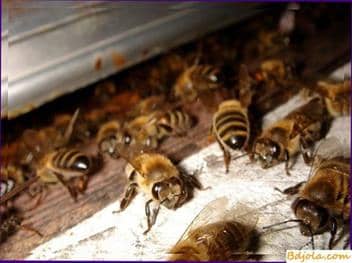
To increase the efficiency of anti-varrotic treatment of bees, we produced a thermocamera, the structure of which has been described with some modifications. The frame of the thermal chamber is made of bars measuring 30X30 mm. The outer walls are made of plywood, and the inner ones are made of textolite.
The front wall consists of two sheets of Plexiglas, inserted in the grooves, so that the glass can be moved freely when placing the cassette in the camera. The cassette rotates in the cross, and not on the rollers, as the author suggests. And the rotation is carried out manually, which makes it possible to adjust its speed. We control the temperature with two thermometers.
Otherwise, the heat chamber is made in accordance with the drawings. To this thermocamera we produced two mesh cassettes with a length of 53, a diameter of 37 cm, into which are placed 3.5 kg of bees. The bottom and covers of the cassette are also made of a mesh and are arched inward, as a result of which it evenly warms up. Of the wooden bars section 40X40 mm made a rigid stand under the cassette, the outside is covered with dermatome, which protects the bees from hypothermia. To collect bees, a funnel made of bars and plywood was made. The funnel is tightly attached to the stand with the cassette, and serves as a support at shaking the bees off the frames.
Treatment is carried out in late October – early November, when there is no brood in the families or very few. If there are small areas with brood on one or two frames, then after removal of the bees, such a framework is deleted. If the brood turns out to be larger, then the frame with it is rearranged into a family, which we will process later. Before processing, the bees are shaken from the frame into the hive, where they gather in a club at one of the walls. Near the hive we put plastic wrap. Then turning over the beehive, the bees are poured onto the film, and already from it into the cassette. We do not select the mats – they do not die during heat treatment. A cassette with bees is brought into the utility room, where the temperature is maintained at 25-27 њ C. Then we select a second family in the cassette, which we also put into the utility room.
At this point, turn on the heat chamber. The hives of the first family are disinfected with a gas burner, warmed up well, forming a nest and insulated. After that we proceed to the processing of the first family. We bring the temperature in the thermal chamber to 55 њ C and place in it a cassette with bees. The temperature drops to 46-48 њ C. From the moment the cassette is staged, we maintain the temperature in the chamber at this level, alternately turning on and off the lamps. Do not increase the temperature above 48 њ C. Two minutes later, a massive scree of mites begins, which lasts about three minutes. Another minute stand bees for control. All processing takes place in six minutes. Its efficiency is achieved due to uniform heating of the cassette, active supply of fresh air and removal of waste.
The bees of the first family are left to cool in the back room, and the second cassette is placed in a thermo chamber. After processing, the bees of the first family are placed in the cassette to the prepared hive and poured into the frames of the formed and heated nest. Bees amicably enter the inter-frame space. During the evening we process eight to ten families.
We came to the conclusion that the internal volume of the thermal chamber should be 1.5-2 times larger than the volume of the cassette. This makes it possible to have a supply of oxygen in the chamber.
With the help of a thermocamera we processed 60 families and believe that using a thermo-chamber of this design, any beekeeper can efficiently process bees from a tick without fear of their steaming.
Советы для начинающего пчеловода. Вычинка шкур.
Diseases of bees